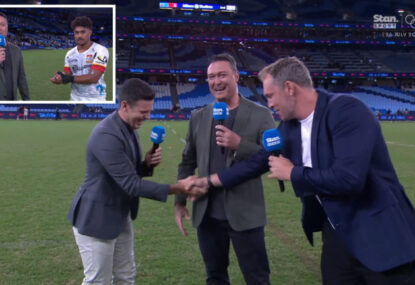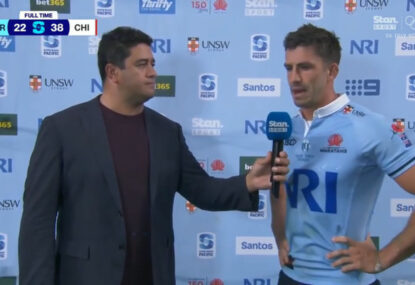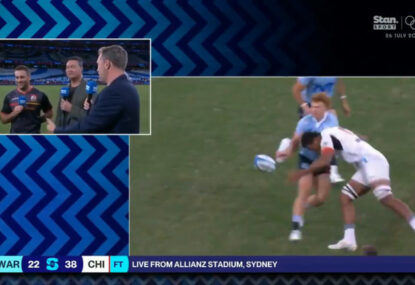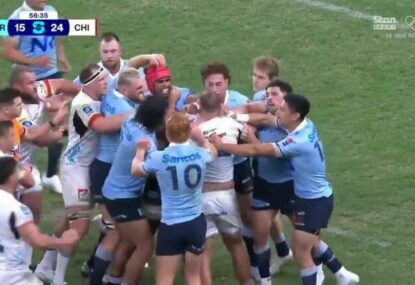It is not enough to delve into who is the best, for that is merely a mixture of petty opinions.
In this article, the playing style of every single one of the world’s prominent tens will be broken down into the molecular parts of their game play. Their defensive play for the first time will not be subjected to heavy scrutiny under eyes that see errors that strike more than that of the scintillating moments.
This is taken from the most recent Tests the player has taken part in, while there might be reference to the 2019 Rugby World Cup and the 2020 Six Nations, plus a look at club rugby.
Beauden Barrett
The man is perhaps best suited to fullback and his flyhalf game may lack in certain aspects such as goal-kicking but that was not altogether horrendous either. What has always stunned me about Barrett was his dazzling, mercurial, fluid skill set.
In the tries the All Blacks scored in 2019, he played a crucial hand. Meanwhile, his 2016-2018 performances don’t require talking about considering how evident it all is. His agility and speed give defenders headaches and he hits the lines hard without needing the physique of a big centre.
In the 16-16 match, the try by Jack Goodhue was the effort stemming from some players. A sublime float pass by Sonny Bill Williams found the designated killer (Barrett) in some space. A defender had cut in to kill a play and just gave Barrett a lot of space on the outside. Barrett then used his deadly pace and ran down field, and with the last-ditch defender fixed he put in an effortless pass on the inside to Goodhue, who went over for the solitary score for the All Blacks in the game.
Meanwhile he is fond of using a long, floating pass over the heads of the opposition to find a man on the outside. These are his other playmaking talents: he uses his dazzling step to slice through poor defensive infrastructures, and then puts in a sublime offload to an open runner so subtly that the defender sees nothing in the fix. He also puts in the chip over the top, or a grubber kick or any kick, and goes tearing after it. With such pace, the battle is already half won, while his handling skills are sublime. His ability to catch any ball when in form is a pain for any defence.
In the match against Canada, a grubber kick forward by Richie Mo’unga had Barrett dive over it, sliding over the ground wet with the rain. His chase skills are perhaps his most prominent type of ability.

(Phil Walter/Getty Images)
Dan Biggar
One of the form flyhalves of the Six Nations, he has shown on multiple occasions his sublime ball skills. In most phases, in the expansive hand of cards Wales hold, he is a distributor. His creativity is evident and he is a highly skilled player and a great flyhalf. He has scored two tries in the 2020 season, one a bundling phase try and another a sniper through the gap from a pass of Hadleigh Parkes.
He has a good vision of gaps and is superb at spotting opportunities. He is superb at making tactical cross kicks. His plays, sadly, have not always worked out, but sometimes due to the errors of others.
As a distributor he gets it out to others to put in a release on the edge. Playing through a series of dummy runners are the spark in the plays.
Against Italy he created one try from the five, which was a phenomenon of a play. A flick through the legs had found a teammate in the corner and the try came.
Handre Pollard
He is the one kind of flyhalf who does magic without taking much of a risk. The 2019 season was the best of years for the flyhalf. Other than his work of the tee, there are three prominent parts that are the cornerstone of his play: contact power, passing, and tactical kicking.
His cross kicks to the wingers are phenomenal and they can set talent like Cheslin Kolbe free to score. His kicking distances are worth innumerable furlongs. His excellent play at the breakdowns makes him a strong support player, who holds out against big forwards at the breakdown. In terms of contact play, he uses his physique as a confident cushion for tackle impact. As a distributor, he gets the ball wide, using himself to bait the colossal tacklers, gets the pass out and take a big hit. With a 98-kilogram frame there are many things he can withstand.
His passing is interwoven with this. There are two prominent examples of that in the 2019 World Cup. Against Japan he fixed his man and put the long pass to the edge, then got pummelled by a hit. Against England the pattern repeated itself. He attracted Sam Underhill, who goes after flyhalves. He lingers and makes himself lucrative bait. Underhill flies in to pulverise Pollard, put a short pass puts a teammate in with a clean break.
The Springboks sometimes play with a pod of three forwards and a distributor behind. On an occasion in the Welsh clash in the semi-finals, he gets a quick ball from behind the pod of three, ripping a flat pass across the pitch to release teammates.
Back to his contact play, Pollard is a hard-carrying back. Against Argentina in the Rugby Championship in 2019, he used low body posture to power through Nicolas Sanchez and fly over the line. Another try in the same match came when he used a diving charge between two defenders to cross the line again. His physical carries are a substitution for the set piece with Damian de Allende. England play with two tens, while the Boks play with two 12s with two strong heavy carry options to cross the gain line.
Over the past two years, he has showed scintillating skill on multiple occasions. Against the Scottish in 2018, he broke the line with agility and pace, with an offload to Embrose Papier. His ability to go for a try after a dummy is due to his agility and solid step. He scored a try after he went through a tackle with pace and power after a dummy.
Against Wales in 2019, he was the heart of their try of the match. A hard carry into a defender and a skilful offload to Malcolm Marx set the play flowing. Following several phases of the nine, Faf de Klerk played deep back out to the ten, which brought up the defence in an uneven pattern. Pollard took advantage of this and cut through the line with a bit of a step. He beat several defenders before being taken down by defenders. The next phase was De Allende’s try.
In the match with Japan in the quarter-finals, after an agile line break off the pass from Franco Mostert, Pollard made some great running metres and sped downfield. As a defender desperately tried to get back to take down the flyhalf, Pollard crossed another defender with a sublime spin pass to Willie le Roux who put Makazole Mapimpi in untouched.
Against England, he put in a superb hanging kick to chase after and used his high ball skills to beat George Ford in the aerial contest for the ball.
In perhaps his best game of the year in which the Boks demolished Argentina, he had showed his amazing passing in the try assist to Mapimpi. As De Klerk played out to the ten behind a dummy runner, Pollard used a fast, flat, sublime pass over the top to find Mapimpi in space. It was a long pass and the fast ball was way more effective than the float pass to find Mapimpi in space and the play was too fast for defenders to halt.
He uses a blend of handling, tactical kicking, sublime passing of a wide variety, and power in game play.

(Photo by Stu Forster/Getty Images)
Finn Russell
In his game, his extraordinary passes are trademark to unlocking any defence. His vision is one part of it. Basically, Russell spots the smallest of gaps and passes to a teammate to try the gap. Few in all time have this talent. His over-the-top, sublime passes are a joy to watch. In the Calcutta matches he has had a long history of shining on the big stage.
Here are two extraordinary passes I will cap on. Sam Johnson’s try was a short pass that Russell’s body language said was to go wide but put Johnson through a smallest of gaps to score using some footwork.
Another pass over the top was spiralling towards a player on the outside, who ran down field and put in the last pass for a try.
Meanwhile, he is fond of using his trademark over-the-top spiral passes to put others free.
For Racing 92 this talent is epitomised with a star-sprinkled back line. He also has a long history of intercept tries. His counterattacking reads have been superb for Racing 92.
His ability to go for any gap is also sublime.
Richie Mo’unga
As a stunning attacker, he uses nippy agility to slice through the line speed structures and score tries. An ability to run tries through tactical kicks is crucial to any team while his ability to break the line and pass on the ball with deft touch is the try factor in the Crusaders franchise. Despite not altogether shining in this year’s Super Rugby, he has had one masterclass performance, which set across a clear message that he was still a world-class ten.
His cross kicks to Sevu Reece are perhaps the best between a ten and a 14. He has created more tries for Reece in the 2019 campaign than for anyone else. He was superb with loose balls and gaps while his ability to find men on the outside with phenomenal cross kicks are his modus operandi.
George Ford
A man superb in going through the gaps in the Premiership, the flyhalf has enough agility to slice through defenders. He also has the crash phases flow off him. As a killer he has the quick hands to put any player free. For Leicester he has the kicks to get teammates tries.
He has got some really great hands on form.
Meanwhile, with too much space in the Premiership, he has used agility to get through the lines on countless occasions.
Owen Farrell
On form he is a great player, and his flat passing is a phenomenon when executed properly. Here are two tries that are Farrell’s passing styles that score. One, in a World Cup warm-up against Ireland, he stopped, turned wide, and fired out a flat ball to Elliot Daly in the loose to put the try-scorer in untouched.
Two, in Manu Tuilagi’s try against Wales, a good pass deeper out fast to George Ford had a defender bite in to take the ten in confidence, helping Ford just put the centre in untouched.
Farrell has many other play styles, including squandering possession, not reading interceptions, and sometimes just wasting the ball. However when he actually executes well, England can score.

(Kaz Photography/Getty Images)
Romain Ntamack
His try creation in the Six Nations has been built around drawing out the defenders and then putting a fast inside runner in for a try. Against England, Vincent Rattez’s try came off a flat pass by a teammate and Ntamack drawing the defence out wider, with Rattez crossing in to take another great pass back into the gap opened up by Ntamack’s draw-out.
His reads to intercept have gotten him a try of his own in this year’s Six Nations as well.
Yu Tamura
Basically, most of the tries he creates are through excellent tactical kicks. There have been numerous occasions when he has created tries on the outside for the two Ferraris of the team: Kotaro Matsushima and Kenki Fukuoka. Chip kicks and cross kicks, a blend of the two, has been his primary function.
Also in open play he is a key out-of-hand kicker. Japan look for him to put in an intelligent kick in the spaces the opposition is pressured and where they have overall territorial game.
He is the distributor in an expansive, passing, quick-recycling game, asking relentless questions of the defensive line, wearing out oppositions.
In perhaps one of the best prop tries of the World Cup in the pool decider with Scotland, he puts a distribution to put a teammate between two defenders. The hooker barrels forward, putting an offload to a man in support as he goes to ground. The centre then uses pace and agility to step around and beat some defenders before a stopping tackle but an offload to a teammate was the try.
Aaron Cruden
This man is one of the best players in the 2020 New Zealand conference. Most of his playmaking is built around stepping the line and offloading. Get the gaps and set someone to score. His passing when he cohesively links up with Damian McKenzie in the line can create great tries.
He has the agility to break gaps with offloads and good hands set others free, as epitomised in his stunner off the bench against Blues in the opener.
A link-up passing play with McKenzie was the cause of Solomon Alaimalo’s try as Cruden took his man and put the fast ball to set McKenzie loose, who had it with absurd ease to put Alaimalo in the corner.





































































































